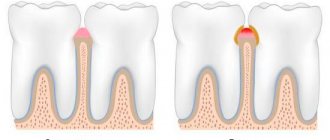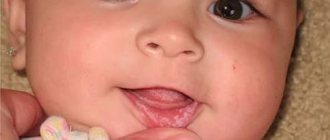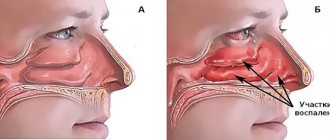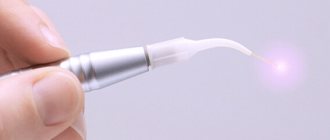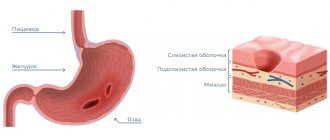Leukoplakia of the oral cavity: causes of the disease
The reasons causing the development of the disease include:
- Smoking. When using tobacco, the oral cavity is exposed to various irritants, including thermal (incoming smoke has a temperature of about 60 degrees Celsius) and chemical (nicotine, tar and combustion products). No less dangerous is chewing tobacco, which is also a provoking factor.
- Eating either very hot or very cold food on a regular basis for a long time.
- Mechanical trauma (bad bite, sharp edges of teeth, orthopedic structures installed with violations).
- Metal seals that cause galvanic currents.
- Inhalation of vapors of gasoline, benzene, varnishes and paints, as well as other resins.
- Hormonal imbalance, constant stress and lack of retinol.
Symptoms
The first signs of the disease often go unnoticed because they do not cause any pain or discomfort in the patient. Nevertheless, a specialist will be able to determine the onset of leukoplakia by the appearance of the mucous membrane, lips and the area where the teeth meet.
The first sign of the disease is the appearance of a keratinized gray area, which can appear on the palate (in smokers), in the corners of the mouth, on the inside of the cheek, etc. An easily removable white plaque forms in this area, but after a few days the formation makes itself felt again . The patient may feel tightness in the mouth, but, as practice shows, most people simply do not pay attention to this.
Plaques with a diameter of no more than 4 centimeters are formed. They may appear:
- on the inner surface of the cheeks;
- on the tongue (on the back or sides);
- in the sky;
- on the gums;
- in the corners of the mouth.
The process of plaque formation takes up to one month. At the first stage, the area of the future formation seems slightly swollen; when you feel it with your fingers, the compaction is not felt. However, over time, another symptom of oral leukoplakia appears - the mucous membrane at the site of the swelling loses its original shine and becomes rough, which is noticeable when touched.
There is no pain in this case: only sometimes a feeling of dryness at the site of the outbreak is possible.
Gradually, the color of the spots changes from gray to bright white. The spots in most cases have clear boundaries. Their increase is possible when the disease enters its second stage, called verrucous.
The disease often causes candidiasis and malignant cancers. In an advanced state, leukoplakia is very difficult to treat: the affected areas become even more keratinized, ulcers can form, and the infection gradually spreads to other areas of the mouth.
How does the disease manifest in children?
In children, the disease occurs in an acute form and is accompanied by the appearance of redness and swelling in the oral mucosa. The child sleeps poorly, may have no appetite, and becomes tearful.
The disease can occur in children for the following reasons:
- Weakening of the immune system.
- Infection during breastfeeding.
- Transmission of the fungus during childbirth.
- Infection through household items.
If the disease is not diagnosed and treated in a timely manner, a whitish coating resembling cottage cheese will soon appear in the child’s mouth, and in an advanced stage, ulcers will appear, which are accompanied by bleeding and cause severe pain in children.
Kinds
- The most common is simple or, as it is also called, flat leukoplakia . It is usually discovered by chance during an examination by a dentist, since the patient does not experience any subjective sensations. A burning sensation occurs extremely rarely, and the appearance of the mucous membrane may change. If the disease affects the tongue, loss of taste may occur.
- Hairy leukoplakia of the tongue resembles stomatitis. The shape of the spot that appears, as well as its size, can be different, the color - from pale gray to white. The surface of the mucous membrane at the site of the lesion becomes slightly rough, which can be felt to the touch. On the cheeks it appears as solid or broken lines. It can also be found on the lips, where it looks like thin paper pasted on.
- Verrucous leukoplakia is the second stage of the development of the disease. The keratinization thickens, the affected area seems to rise above the nearby tissues. When you touch it with your fingers, you feel a compaction.
- Erosive form . Untimely diagnosis of the two previous stages of the disease leads to a worsening of the situation - the person feels pain when exposed to any irritants, erosions or ulcers are visible in the mouth.
- Soft leukoplakia is a type of cancer. Its distinctive feature is peeling of tissue in the area of the lesion. To clarify the diagnosis, a histological method of studying cells is required.
- Tappeiner's leukoplakia . This form of the disease affects people who abuse smoking. According to studies, daily smoking 10 cigarettes a day increases the chance of developing the disease by 50 times (as the number of cigarettes increases, the risk also increases)
The disease begins with the formation of lesions on the roof of the mouth (sometimes they appear on the gums). The mucous membrane changes its color to a pronounced gray or bluish, which is noticeable to the naked eye, folds appear on it. Reddish nodules may begin to appear, which is accompanied by infectious inflammation of the oral cavity (caused by the accumulation of salivary gland secretions in the tissues).
Diagnosis of oral leukoplakia
Treatment of any disease begins with diagnosis: leukoplakia is no exception in this regard.
During the examination, the doctor interviews the patient to determine the factors contributing to the development of the disease. These include regular exposure to tobacco smoke, working in hazardous conditions, recent dental surgery, etc.
Next, laboratory tests are prescribed. The following procedures can be carried out:
- tissue sampling (biopsy). Accompanied by anesthesia;
- examination of the collected material under a microscope. The method allows you to determine the presence or absence of cancer cells in the formation;
- a smear of the mucous membrane is taken;
- A Schiller test is done (the mucous membrane is stained with a solution consisting of water and iodine - foci of leukoplakia are not stained);
- blood is taken for analysis (an increase in ESR may indicate the presence of malignant neoplasms).
In addition, the doctor may additionally prescribe a urine test, conduct a biochemical blood test and request the result of fluorography. You may need to consult an oncologist (if cancer is suspected), a therapist (to rule out infectious diseases) and a dermatologist (to look for other foci of disease).
Leukoplakia of the oral cavity: treatment with medications
Treatment involves the complete elimination of irritating factors that led to the development of the disease:
- to give up smoking;
- grinding down sharp edges of teeth;
- sanitation of the oral cavity;
- replacement of fillings;
- use of products to protect the surface of the lips.
Additionally, a course of vitamin A is prescribed, lasting at least a month, which inhibits the process of tissue keratinization.
If the measures taken do not cause complete disappearance of the manifestations of the disease, surgical intervention is allowed: the lesion is excised, depending on the degree of development of the disease, cryodestruction or electrocoagulation is used.
Ulcers deserve special attention, as they can develop into cancerous tumors. For their treatment, drugs are prescribed that enhance the process of tissue regeneration and epithelization. If there is no positive dynamics, surgical intervention cannot be avoided.
A person with leukoplakia must constantly visit the dentist for examination to prevent malignant degeneration of the cells.
In addition to quitting smoking, the patient’s diet is adjusted: during treatment, spicy and too salty foods are excluded from the diet, and it is recommended to eat more vegetables and fruits.
Drugs prescribed:
- products that restore the epithelium (the most effective was 30 percent tocopherol acetate, which is applied to damaged areas three times a day for 15 minutes, after which it is washed off with water);
- antiseptics (after each meal it is recommended to rinse your mouth with a solution of chlorhexidine at a concentration of 0.05%);
- analgesics (their use is justified in the presence of pain. Lidocaine, applied to the mucous membrane before meals, has worked well).
Under no circumstances should you use drugs that have an irritating effect, as otherwise this can lead to the formation of cancer cells.
If there is no improvement within a couple of weeks, surgery is prescribed: this can be either excision with a scalpel or the application of cold in the form of a liquid stream of nitrogen.
With bullous dermatoses, isolated lesions of the oral cavity occur in 60-90% of cases. The diagnosis during the initial visit to medical care for patients with blistering dermatoses is made only in 9-30% of cases [4, 9].
In the early stages of disease development with isolated lesions of the oral mucosa (OM), the differential diagnosis of pemphigus vulgaris, bullous pemphigoid and lichen planus (LP), which is carried out taking into account clinical, pathomorphological, and immunological signs, is particularly difficult.
Pemphigus vulgaris
(pemphigus) is a severe autoimmune bullous disease characterized by disruption of intercellular contacts in the suprabasal layers of the epidermis, caused by the production of IgG to intercellular adhesion proteins, leading to acantholysis and the formation of blisters and erosions on the skin and (or) mucous membranes [6, 9, 11]. Pemphigus most often affects women of working age (40-60 years).
The main target of autoantibodies are the structural elements of desmosomes on the cell surface of keratinocytes: type 1 desmogleins (antigen molecular weight - 160 kD), type 3 desmogleins (molecular weight - 130 kD), as well as desmocollins, cadherin-type adhesion molecules - transmembrane glycoproteins with an extracellular domain - and other proteins [10].
With pemphigus vulgaris, in 67-85% of cases, the first signs of the disease are observed on the mucous membranes. Lesions of the oral cavity remain the main symptom for a long time (up to several years from the onset of the disease) [4, 12].
Patients are concerned about severe pain in the areas of the rash, difficulty chewing and swallowing, severe salivation, deep cracks in the corners of the mouth that prevent it from opening [17].
The clinical picture of pemphigus vulgaris is characterized by the formation of blisters ranging in size from 1-2 mm to 10 cm or more with a thin cover, transparent or cloudy contents, oval, pear-shaped or irregular in shape on the apparently unchanged mucous membranes of the pharynx, cheeks (mainly in the retromolar region), lateral surface tongue, hard and soft palate, sublingual region, larynx, pharynx, esophagus. The blisters, quickly opening, form easily bleeding erosions of a pinkish-yellowish color with a shiny moist surface, covered with an easily removable fibrinous coating, bordered by fragments of epithelium (remnants of the bladder cover) [5, 17] (Fig. 1,). In some cases, erosions rapidly increase in size, affecting large areas of the SOP. The predominance of erosions over cystic elements on the oral cavity leads to difficulties in diagnosing pemphigus. Slow epithelization of erosions is characteristic even with adequate glucocorticosteroid therapy [7].
Rice. 1. Clinical and morphological signs of pemphigus vulgaris. a - erosions on the oral mucosa in patient M. with pemphigus vulgaris; b - pathomorphological picture in a biopsy taken from the oral mucosa: acanthosis of the epithelium, suprabasal bladder, acantholytic cells in the cavity of the bladder; c — direct immunofluorescence reaction (confocal laser scanning microscopy ×1000). Fixation of IgG in the intercellular spaces of the epidermis in a patient with pemphigus vulgaris.
Nikolsky and Asbo-Hansen symptoms in patients with pemphigus are positive. With the cytological diagnostic method, acantholytic cells are found in impression smears from the bottom of erosions.
Characteristic signs in the pathomorphological examination of biopsy specimens obtained from the lesion on the SOR are suprabasal fissures and blisters (in some cases in the lower parts of the spinous layer of the epidermis), in the cavity of which there are fibrin filaments and round acantholytic cells with eosinophilic cytoplasm and a large hyperchromic nucleus , which can be located isolated or in the form of small clusters. The cavity of the bladder may contain single eosinophilic leukocytes [16] (see Fig. 1, b). Biopsy of an intact bladder is extremely difficult due to the high vulnerability of the bladder covers.
The “gold standard” in the diagnosis of pemphigus for the detection of fixed immunoglobulins in the mucous membranes and skin is the immunofluorescent method. However, when performing a direct immunofluorescence reaction (RIF), the detection of fixed IgG in the intercellular substance of the oral cavity is not always informative, since fluorescence is also noted in the normal gingival epithelium [10].
The results of RIF, obtained from the study of biopsy specimens of apparently unaffected skin, have diagnostic value. In pemphigus vulgaris, fixed immunoglobulin IgG (less commonly, IgA, IgM and complement components) are detected in the skin already in the early stages of the disease and are localized in the intercellular spaces of the spinous layer of the epidermis (see Fig. 1, c). In some cases, deposition of immunoglobulins and complement components is observed not only in the intercellular space of the epidermis, which is typical for pemphigus vulgaris, but also in the zone of the dermoepidermal junction, which complicates the differential diagnosis of pemphigus and pemphigoid [3, 13].
Using enzyme immunoassay (serological diagnostic method), circulating antibodies to desmogleins types 1 and 3 are detected. In pemphigus vulgaris with isolated lesions of the oral cavity, antibodies to desmoglein type 3 are detected, while in the presence of rashes on the mucous membranes and skin, antibodies to desmoglein of both type 1 and type 3 are detected. The level of autoantibodies to desmogleins statistically significantly correlates with the severity of the disease [12].
Bullous pemphigoid -
acquired autoimmune subepidermal cystic dermatosis of a benign course, characterized by the deposition of IgG to transmembrane glycoproteins of desmosomes along the basement membrane and is more common in elderly patients (60-70 years) [11, 12].
In bullous pemphigoid, antibodies are formed to proteins of the basement membrane: glycoprotein of the inner plate of the hemidesmosome BP230 (BPAG1; molecular weight - 230 kD) and transmembrane hemidesmosomal glycoprotein BP180 (BPAG2; molecular weight - 180 kD [13].
Isolated lesions of the oral cavity in bullous pemphigoid occur in 10-20% of cases. Patients are bothered by itching when rashes appear.
The clinical picture of bullous pemphigoid is characterized by blisters on the mucous membranes of the cheeks and gums, as well as the hard palate, rarely - the pharynx, larynx, ranging in size from a few millimeters to 5-10 cm in diameter or more, with a thick covering, serous or serous-hemorrhagic contents on hyperemic background, persisting for several days [11].
When the blisters are opened, painful erosions are formed with clear boundaries without a tendency to peripheral growth, bleeding easily, without fibrinous plaque, covered with serous or serous-hemorrhagic crusts, relatively quickly epithelializing with the formation of pigmentation [9] (Fig. 2, a,).
Rice. 2. Clinical and morphological signs of bullous pemphigoid. a, b — erosions on the oral mucosa in patient K. with bullous pemphigoid; c — pathomorphological picture of bullous pemphigide; d — direct immunofluorescence reaction (confocal laser scanning microscopy ×1000). Fixation of IgG along the basement membrane in a patient with bullous pemphigoid.
Nikolsky's sign on apparently unchanged skin is negative, however, when pulling on pieces of the bladder cover, the symptom of perifocal detachment is determined at a distance of more than 2-3 mm. Asbo-Hansen's symptom is positive.
In patients with pemphigoid, the cytological method of diagnosis reveals a large number of eosinophils (>20-30%) in imprint smears obtained from the bottom of fresh blisters (>20-30%) and no acantholytic cells [11].
Pathomorphological examination of biopsy specimens reveals a subepidermal cavity or bubble. In most cases, the cavity of the bladder and the underlying areas of the dermis contain numerous eosinophilic leukocytes, lymphocytes and an admixture of neutrophilic leukocytes. Intercellular edema with the penetration of eosinophilic leukocytes into the epidermis (eosinophilic spongiosis) can be observed in the epidermis along the periphery of the cavity [14] (see Fig. 2, b).
Indirect RIF reveals linear deposition of IgG along the basement membrane (see Fig. 2, c). RIF detects circulating IgG to basement membrane proteins in 65-90% of cases [10].
In the early stages of development with isolated lesions of the oral cavity, the differential diagnosis of pemphigus vulgaris and bullous pemphigoid is particularly difficult (Table 1).
Table 1. Diagnostic signs of pemphigus vulgaris and bullous pemphigoid
PL
- a chronic autoimmune, mediated by T cells, including CD4+ and CD8+, disease of the skin and mucous membranes, characterized by polymorphism of rashes. PL occurs at any age, more often in women 30–60 years old [2, 7, 8].
In the development of the inflammatory process in the epithelium of the oral cavity during LP, both T-helper cells and T-killer cells play an important role. However, only CD8+ T cells penetrate directly into the epithelial layer; CD4+ T lymphocytes and B cells are absent in the epithelium. The detection of a large fraction of CD4+ lymphocytes in the infiltrates confirms the role of T helper cells in the formation of the local immune response. However, only CD8+ T cells have a direct destructive effect on epithelial cells [1]. With different forms of PL SOR, polyclonal activation of B cells is observed - an increase in the level of IgG, IgM, IgA in the serum. At the same time, there is a decrease in IgE levels [7].
Damage to the oral cavity in LP (isolated or in combination with skin lesions) occurs in 60-80% of cases. Patients are concerned about pain when eating, burning.
The clinical picture of LP is diverse and is characterized by many forms: typical (keratotic nodules form a mesh on the mucosa); exudative-hyperemic; erosive-ulcerative; bullous and atypical. Most often, with LP, the mucous membrane of the cheeks, tongue, and retromolar space is affected, less so - the gums, floor of the mouth, and hard palate [15].
A severe course of the disease is observed in erosive-ulcerative (occurs in 23% of cases) and bullous forms of P.L. In the erosive-ulcerative form, erosions (less often, ulcers) of a polygonal shape appear, covered with a fibrinous coating, prone to fusion, around which typical papular rashes are located on a hyperemic and edematous base (Fig. 3, a). The bullous form is characterized by the appearance, along with typical papular rashes on the oral cavity, of vesicles and blisters ranging in size from 2-3 mm to 1-1.5 cm in diameter, with serous or serous-hemorrhagic content, with a thick covering, lasting up to 2 days. Blisters form only within the papular elements and only with a generalized process can they appear on apparently unchanged skin. When the blisters are opened, erosions are formed, covered with fibrinous plaque, hemorrhagic or serous-hemorrhagic crusts (hemorrhagic form of LP). The bottom of erosions bleeds easily [11, 14] (see Fig. 3, b).
Rice. 3. Clinical and morphological signs of lichen planus. a — erosive-ulcerative form of lichen planus; b — bullous form of lichen planus; c — pathomorphological picture of lichen planus. Electron diffraction pattern. A spiny cell with signs of activation of the lysosomal apparatus. Large lysosomes (L) and the formation of lysophagosomes (LF) on the basis of a lysosome. Leaching of the mitochondrial matrix (M). Desmosomes (D) of epithelial cells; d - electron diffraction pattern. A group of megamitochondria with atypical membrane structures; d — indirect immunofluorescence reaction, staining for CD45. Massive lymphoid infiltration of the oral mucosa in lichen planus. Diapedesis of lymphocytes, many dendritic cells in the epithelium; f - pathological expression of the CD29 molecule on epithelial cells of the oral mucosa in lichen planus.
Different forms of PL can transform into one another [1, 8, 15]. On the mucous membrane of the cheeks and the red border of the lips, in rare cases, PL can become malignant [11, 14].
The isomorphic Koebner reaction (the appearance of new elements at the site of irritation of the oral cavity under the influence of exogenous factors) has an important diagnostic value in PL; dull white glow of the affected area in Wood's rays.
Imprint smears reveal destroyed, anucleate epithelial cells or cells with eccentrically located nuclei, and an abundance of coccal flora.
Pathomorphological signs of PL are: subepidermal cavities, hyper- and parakeratosis; hypergranulosis; lymphocytic infiltrate; vacuolar degeneration in the stratum spinosum; acanthosis, uneven epithelial hyperplasia; perivasculitis; fragments of minor salivary glands surrounded by a round cell type infiltrate [1, 16] (see Fig. 3, c).
The main feature of the structure of the epithelial cover of the oral cavity in PL, according to E.V. Ivanova (2003), is the appearance of apoptotic bodies and giant mitochondria in the basal and spinous layers (see Fig. 3, d). Typical morphological signs are penetration of lymphocytes into the basal layer of the epidermis and a pronounced reaction of dendritic cells in it (see Fig. 3, e). In areas of lesions during PL on COP cells, a decrease in the expression of CD 29 molecules in the cells of the basal layer is observed [1] (see Fig. 3, f).
When examined by direct immunofluorescence, abundant accumulations of fibrin are detected at the border between the epidermis and dermis, in Siwatt bodies - IgM, less often - IgA, IgG and the complement component [11] (Table 2).
Table 2. Differential diagnosis of pemphigus vulgaris and PL
Doctors of different specialties experience difficulties in the differential diagnosis of bullous dermatoses with isolated lesions of the oral cavity. Diagnostic errors lead to delays in treatment of patients with severe dermatoses: pemphigus vulgaris, bullous pemphigoid, PL and others.
The main points preventing timely diagnosis are:
— the variety of diseases in which pathological changes (elements) are localized on the oral cavity, and the similarity of their clinical manifestations;
— rapid changes in the clinical picture under the influence of exogenous and endogenous factors;
- predominantly chronic relapsing course of diseases.
In everyday practice, doctors often make a diagnosis of cystic dermatoses only on the basis of the results of clinical and (or) cytological studies, which often leads to diagnostic errors. None of the modern clinical and laboratory diagnostic methods allows making a diagnosis with absolute certainty, and therefore, for timely diagnosis and prescribing adequate therapy, it is advisable to thoroughly examine the patient by doctors of related specialties and use a set of data from clinical, morphological, immunological testing as a differential test. diagnostic criteria.
Thus, with isolated lesions of the oral cavity in bullous diseases, it is important to use an interdisciplinary approach, which can help recognize and diagnose the early manifestations of these diseases.
Oral leukoplakia: how to treat it at home
In addition to drug treatment, oral leukoplakia can be treated with traditional medicine.
There are many recipes, here are just the main ones:
- rinsing with herbs (infusions of oregano, chamomile, ginseng and other adaptogens that reduce the inflammatory process and increase the body’s resistance to harmful factors are suitable);
- regular consumption of nuts and tinctures based on them;
- rinsing with decoctions of calendula, St. John's wort, eucalyptus. Alternation works well - once the oral cavity is rinsed with a soda solution, after a couple of hours - with an infusion of herbs. This procedure should be repeated at least 5 times a day;
- lubricating the lesions with sea buckthorn and olives (the fruits must first be mashed in your hands so that the juice appears).
Timely detection of the disease and compliance with all doctor’s recommendations is the key to recovery in the shortest possible time and reducing the risk of complications. If you start treatment at the initial stage, you can reduce the likelihood of complications to almost zero.
How to treat oral candidiasis?
Treatment is carried out using local and general, specific and symptomatic remedies. Among the main goals of therapy are the elimination of foci of infection in the oral cavity (sanitation), treatment of diseases that accompany candidiasis and are risk factors, and stimulation of the body's defenses. The total duration of treatment is usually at least 7-10 days.
As a means of local therapy, rinses are used - using solutions of boric acid, soda, sodium tetraborate. For a longer and more effective effect, such products can be used in the form of applications - moistening a cotton swab or bandage with the solution.
Nystatin for oral candidiasis is used to combat the main cause of the disease - a fungal infection. Treatment of candidiasis in the mouth may also include the use of other antimycotic (antifungal) drugs - for example, levorin ointment. The best effect is achieved by using several drugs, alternating them for several days.
Antifungal drugs are also prescribed for systemic therapy - in this case, medications for oral candidiasis and other infections such as Lamisil, Diflucan, Levarin, Nizoral, etc. are taken orally. In the most severe cases of the disease, the treatment regimen includes taking immunomodulatory drugs, as well as the use other agents that have a stimulating effect on the immune system and help strengthen the body’s own defenses.
An equally important task is to protect against additional fungal and bacterial infections that can join the Candida infection and complicate the course of the disease. For this purpose, rinses with antiseptic solutions - fucorcin, iodinol and others.
As an alternative, you can use ASEPTA antiseptic mouth rinse, which contains the active ingredients chlorhexidine and benzydamine. Both of these substances have broad antimicrobial effects. Regular use of ASEPTA rinses also has a pronounced anti-inflammatory effect and helps not only eliminate unpleasant symptoms, but also reduce the risk of complications.
